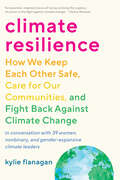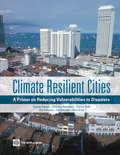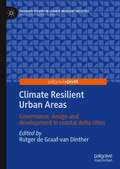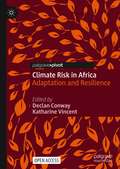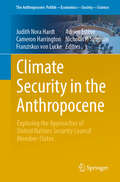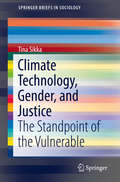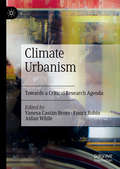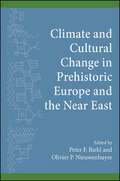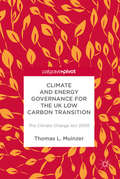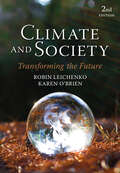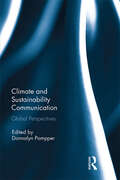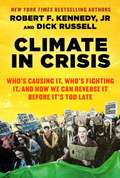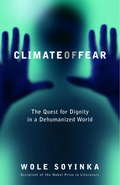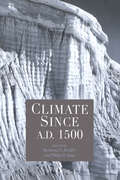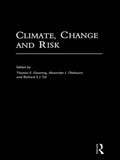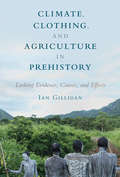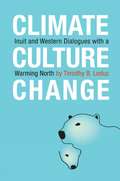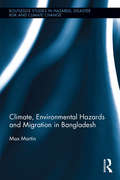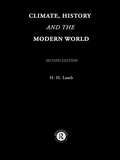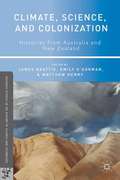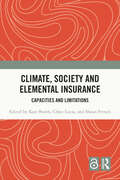- Table View
- List View
Climate Realism: The Aesthetics of Weather and Atmosphere in the Anthropocene (Routledge Research in the Anthropocene)
by Edited by Lynn Badia, Marija Cetinic,́ and Jeff DiamantiThis book sets forth a new research agenda for climate theory and aesthetics for the age of the Anthropocene. It explores the challenge of representing and conceptualizing climate in the era of climate change. In the Anthropocene when geologic conditions and processes are primarily shaped by human activity, climate indicates not only atmospheric forces but the gamut of human activity that shape these forces. It includes the fuels we use, the lifestyles we cultivate, the industrial infrastructures and supply chains we build, and together these point to the possible futures we may encounter. This book demonstrates how every weather event constitutes the climatic forces that are as much social, cultural, and economic as they are environmental, natural, and physical. By foregrounding this fundamental insight, it intervenes in the well-established political and scientific discourses of climate change by identifying and exploring emergent aesthetic practices and the conceptual project of mediating the various forces embedded in climate. This book is the first to sustain a theoretical and analytical engagement with the category of realism in the context of anthropogenic climate change, to capture climate’s capacity to express embedded histories, and to map the formal strategies of representation that have turned climate into cultural content.
Climate Resilience: How We Keep Each Other Safe, Care for Our Communities, and Fight Back Against Climate Change
by Kylie FlanaganAn intersectional primer for saving the planet: place-based perspectives and community-led tools for fighting climate change—for readers of The Intersectional Environmentalist and All We Can Save"An essential, inspired chorus of voices echoing the urgency of action in the fight against climate change." —Kirkus ReviewsIn Climate Resilience, climate justice and resilience strategist Kylie Flanagan invites us to see and act beyond status-quo solutions, Big Tech promises...and everything we&’re usually told about how to save the planet.Centering the voices of Native Rights activists, queer liberation ecologists, youth climate-justice organizers, Latinx wilderness activists, and others on the front lines, Climate Resilience urges us toward a vision of climate care that invests in place-based, community-led projects focused on:Relationship RepairEcological RestorationEconomic RegenerationCollective CareCommunity AdaptationCultural StrategyPeople PowerEach section offers practical blueprints for engaging with different aspects of climate-change action through mutual aid, seed-saving, community-owned energy, community safety plans, and more, and includes a range of ideas for readers to apply these strategies in their own communities.
Climate Resilient Cities: A Primer on Reducing Vulnerabilities to Disasters
by Federica Ranghieri Fatima Shah Earl Kessler Neeraj Prasad Zoe Trohanis Ravi Sinha'Climate Resilient Cities: A Primer on Reducing Vulnerabilities to Disasters' provides city administrators with exactly what they need to know about the complex and compelling challenges of climate change. The book helps local governments create training, capacity building, and capital investment programs for building sustainable, resilient communities. A step-by-step self-assessment challenges policymakers to think about the resources needed to combat natural disasters through an innovative "hot spot" risk and vulnerability identifi cation tool. This primer is unique from other resources in its treatment of climate change using a dual-track approach that integrates both mitigation (lowering contributions to greenhouse gases) and adaptation (preparing for impacts of climate change) with disaster risk management. The book is relevant both to cities that are just beginning to think about climate change as well as those that already have well established policies, institutions, and strategies in place. By providing a range of city-level examples of sound practices around the world, the book demonstrates that there are many practical actions that cities can take to build resilience to climate change and natural disasters.
Climate Resilient Urban Areas: Governance, design and development in coastal delta cities (Palgrave Studies in Climate Resilient Societies)
by Rutger de Graaf-van DintherThis book describes the urgent challenge faced by cities worldwide to become resilient to climate change impacts. This challenge goes further than the ability to resist the impacts of extreme weather conditions. Coping with climate impacts and the ability to recover from them are equally important, as well as the capacity to adapt to the effects of climate change and the ability to transform the entire urban system. The book explores how the resilience journey for coastal cities in particular encompasses using scientific knowledge but also the knowledge of citizens and practitioners. Measures and strategies on different scales are needed, from national scale all the way down to neighbourhood, street level and building level. Representing the holistic nature of climate resilience, this collection contains unique insights from leading scientists and practitioners in areas of expertise such as engineering, social sciences and urban design. It will be a valuable resource for scholars, students, practitioners and policy makers interested in the development of resilient and sustainable urban environments.
Climate Risk in Africa: Adaptation and Resilience
by Declan Conway Katharine VincentThis open access book highlights the complexities around making adaptation decisions and building resilience in the face of climate risk. It is based on experiences in sub-Saharan Africa through the Future Climate For Africa (FCFA) applied research programme. It begins by dealing with underlying principles and structures designed to facilitate effective engagement about climate risk, including the robustness of information and the construction of knowledge through co-production. Chapters then move on to explore examples of using climate information to inform adaptation and resilience through early warning, river basin development, urban planning and rural livelihoods based in a variety of contexts. These insights inform new ways to promote action in policy and praxis through the blending of knowledge from multiple disciplines, including climate science that provides understanding of future climate risk and the social science of response through adaptation.The book will be of interest to advanced undergraduate students and postgraduate students, researchers, policy makers and practitioners in geography, environment, international development and related disciplines.
Climate Security in the Anthropocene: Exploring the Approaches of United Nations Security Council Member-States (The Anthropocene: Politik—Economics—Society—Science #33)
by Judith Nora Hardt Cameron Harrington Franziskus Von Lucke Adrien Estève Nicholas P. SimpsonThe speed and scale of climate change presents unique and potentially monumental security implications for individuals, future generations, international institutions and states. Long-dominant security paradigms and policies may no longer be appropriate for dealing with these new security risks of the Anthropocene. In response to this phenomenon, this book investigates how states have reacted to these new challenges and how their different understandings of the climate-security nexus might shape global actions on climate change. It focuses on the perceptions, framings, and policies of climate security by members of the United Nations Security Council (UNSC), the world's highest ranking multilateral security forum. Empirically, the book presents detailed, bottom-up case studies from local authors of every UNSC member state in 2020. It combines this with an innovative theoretical approach spanning national, human and ecological security that helps to capture the complex dynamics of state-led approaches to dealing with security in the Anthropocene. This book therefore offers readers a compelling picture of climate-security politics in the UNSC, beyond Council debates and resolutions. By comparing and contrasting how different framings of climate security impact various policy sectors of members states, the authors are able to assess the barriers and opportunities for addressing climate security locally and globally.“This timely contribution to the literature on climate security examines the under-analysed relationship between the policy approaches of key countries at the national, and at the international level. Policy alignment at multiple levels of governance will be critical if we are to respond adequately to the ubiquitous challenges posed by climate change and variability.” Shirley Scott, Head of School and Professor, School of Humanities and Social Sciences, UNSW Canberra at the Australian Defence Force Academy (Australia).
Climate Technology, Gender, and Justice: The Standpoint Of The Vulnerable (Springerbriefs In Sociology Ser.)
by Tina SikkaThis book is the first to undertake a gendered analysis of geoengineering and alternative energy sources. Are either of these technologies sufficiently attendant to gender issues? Do they incorporate feminist values as articulated by the renowned social philosopher Helen Longino, such as empirical adequacy, novelty, heterogeneity, complexity and applicability to human needs? The overarching argument in this book contends that, while mitigation strategies like solar and wind energy go much further to meet feminist objectives and virtues, geoengineering is not consistent with the values of justice as articulated in Longino's feminist approach to science. This book provides a novel, feminist argument in support of pursuing alternative energy in the place of geoengineering. It provides an invaluable contribution for academics and students working in the areas of gender, science and climate change as well as policy makers interested in innovative ways of taking up climate change mitigation and gender.
Climate Urbanism: Towards a Critical Research Agenda
by Vanesa Castán Broto Enora Robin Aidan WhileThis book argues that the relationship between cities and climate change is entering a new and more urgent phase. Thirteen contributions from a range of leading scholars explore the need to rethink and reorient urban life in response to climatic change. Split into four parts it begins by asking ‘What is climate urbanism?’ and exploring key features from different locations and epistemological traditions. The second section examines the transformative potential of climate urbanism to challenge social and environmental injustices within and between cities. In the third part authors interrogate current knowledge paradigms underpinning climate and urban science and how they shape contemporary urban trajectories. The final section focuses on the future, envisaging climate urbanism as a new communal project, and focuses on the role of citizens and non-state actors in driving transformative action. Consolidating debates on climate urbanism, the book highlights the opportunities and tensions of urban environmental policy, providing a framework for researchers and practitioners to respond to the urban challenges of a radically climate-changed world.
Climate and Cultural Change in Prehistoric Europe and the Near East (SUNY series, The Institute for European and Mediterranean Archaeology Distinguished Monograph Series)
by Peter F. Biehl; Olivier P. NieuwenhuyseThe subject of climate change could hardly be more timely. In Climate and Cultural Change in Prehistoric Europe and the Near East, an interdisciplinary group of contributors examine climate change through the lens of new archaeological and paleo-environmental data over the course of more than 10,000 years from the Near East to Europe. Key climatic and other events are contextualized with cultural changes and transitions for which the authors discuss when, how, and if, changes in climate and environment caused people to adapt, move or perish. More than this publication of crucial archaeological and paleo-environmental data, however, the volume seeks to understand the social, political and economic significance of climate change as it was manifested in various ways around the Old World. Contrary to perceptions of threatening global warming in our popular media, and in contrast to grim images of collapse presented in some archaeological discussions of past climate change, this book rejects outright societal collapse as a likely outcome. Yet this does not keep the authors from considering climate change as a potential factor in explaining culture change by adopting a critical stance with regard to the long-standing practice of equating synchronicity with causality, and explicitly considering alternative explanations.
Climate and Energy Governance for the UK Low Carbon Transition: The Climate Change Act 2008
by Thomas L MuinzerThe UK Climate Change Act was the first case of a country implementing blanket legally binding long-term emissions reduction targets in order to combat climate change. This book provides the first accessible and in-depth analysis of the UK’s complex Climate Change Act framework, presenting the discussion in a clear and interdisciplinary manner designed to open the workings of the challenging framework to a broad audience. It discusses the political ‘story’ surrounding the framework, and its treatment in scholarly environmental literature; analyses the technical content of the Act; explores the framework’s international significance, and its internal ‘subnational’ dimensions and impact, engaging the UK’s devolved jurisdictions of Northern Ireland, Scotland, and Wales. This first, much-needed interdisciplinary treatment of the framework is both introductory and analytical in nature and will be of interest to scholars, practitioners and general readers of environmental studies, policy and governance.
Climate and Human Migration
by Robert A. MclemanStudies warn that global warming and sea level rise will create hundreds of millions of environmental refugees. While climate change will undoubtedly affect future migration patterns and behavior, the potential outcomes are more complex than the environmental refugee scenario suggests. This book provides a comprehensive review of how physical and human processes interact to shape migration, using simple diagrams and models to guide the researcher, policy maker and advanced student through the climate-migration process. The book applies standard concepts and theories used in climate and migration scholarship to explain how events such as Hurricane Katrina, the Dust Bowl, African droughts, and floods in Bangladesh and China have triggered migrations that haven't always fit the environmental refugee storyline. Lessons from past migrations are used to predict how future migration patterns will unfold in the face of sea level rise, food insecurity, political instability, and to review options for policy makers.
Climate and Society: Transforming the Future
by Karen O'Brien Robin LeichenkoThis bold and passionate textbook has become a go-to introduction to current and emerging thinking on the social dimensions of climate change, presenting key concepts and frameworks for understanding the multifaceted connections between climate and society. Using clear language and powerful examples, Robin Leichenko and Karen O'Brien explore the varied social drivers, impacts, and responses to climate change. They highlight the important roles that worldviews, values, and – especially in this updated edition – emotions play in shaping interpretations of climate challenges. They include additional material on climate justice and equity, eco-centric discourses, paradigm shifts, and other topics. Situating climate change within the context of a rapidly changing world, the book demonstrates how dynamic political, economic, and environmental contexts amplify risks, often unequally for different groups based on race, gender, wealth, and location. Yet these shifting conditions also present opportunities for transformative responses: the new edition strengthens its emphasis on individuals’ power to influence systems, structures, and cultures. With updated references, examples, and data, and expanded pedagogical features, this informative and engaging new edition empowers undergraduates across the social sciences and other disciplines with a broader and deeper understanding of climate change and the potential for equitable and sustainable responses.
Climate and Sustainability Communication: Global Perspectives
by Donnalyn PompperClimate and Sustainability Communication: Global Perspectives builds upon traditional approaches to understanding the role of mass media in shaping social issues by amplifying diverse perspectives of opinion leaders, as well as voices of those affected by climate and sustainability issues. From South Korea and China, to the United States and Zambia, the studies reported in this book—compiled using a variety of formal research methods, including content analysis, interview, and survey—emphasize cultural orientation and global implications of climate and sustainability concerns and issues. The contributors explore the cultures, geographies, and media systems underpinning climate and sustainability campaigns emerging around the world, how we theorize about them, and the ways in which media are used to communicate about them. The way in which complex problems and opportunities associated with globalization and power inequities interplay with climate and sustainability communication requires creative, interdisciplinary, approaches. This book opens new conversations for integrating scholarly arenas of mass media communication, science and environmental communication, political communication, and health communication, as well as their respective theory and research method sets. This book was originally published as a special issue of Mass Communication and Society.
Climate in Crisis: Who's Causing It, Who's Fighting It, and How We Can Reverse It Before It's Too Late
by Dick Russell Robert F. Kennedy Jr.The science is overwhelming; the facts are in. The planet is heating up at an alarming rate and the results are everywhere to be seen. Yet, as time runs out, climate progress is blocked by the men who are profiting from the burning of the planet: Energy moguls like the Koch brothers and ExxonMobil CEO Rex Tillerson. Powerful politicians like Senators Mitch McConnell and Jim Inhofe, who receive massive contributions from the oil and coal industries. Most of these men are too intelligent to truly believe that climate change is not a growing crisis. And yet they have put their profits and careers ahead of the health and welfare of the world&’s population—and even their own children and grandchildren. How do they explain themselves to their offspring, to the next generations that must deal with the environmental havoc that these men have wreaked? With a new introduction from the authors, Climate in Crisis takes a very personal look at this global crisis, literally bringing it home.
Climate of Fear: The Quest for Dignity in a Dehumanized World
by Wole Soyinka"Wole Soyinka was the first African to be awarded the Nobel Prize for Literature. In this year's prestigious series of Reith Lectures, Soyinka considers fear as a predominant theme in the world of politics"
Climate of the Middle: Understanding Climate Change as a Common Challenge (SpringerBriefs in Climate Studies)
by Arjen SiegmannThis Open Access book presents a multidisciplinary perspective to increase our understanding of climate policies that are rooted in the natural moral inclinations of people, families and firms. Which policies prevent a widening gap between higher and lower educated people? Which policy instruments are there, and how could they be used? What is the role of free entrepreneurship?In this book, academics from different fields have brought together their knowledge and expertise to reflect on the following three questions: How are the polarised positions on climate change of different groups related to their moral outlook, world view, tradition, cultural norms and values? What is a good distribution of responsibilities between firms, households and the government relating to climate change? What are possible avenues where the climate policies are a natural extension of moral inclinations of families and firms, such as the stewardship for the natural environment and the climate? This book will be of interest to policy and decision-makers, students of social and behavioural sciences, and those interested climate change policies and how this effects our lives
Climate since AD 1500
by Raymond S. Bradley Philip D. JonesFirst Published in 2004. Climate Since A.D. 1500 presents a unique perspective on the 'Little Ice Age' and the climate of the twentieth century. Leading scientists explore historical documents, dendroclimatic data and ice core records from all over the world, presenting an invaluable compilation for all those concerned with past climate and the risks of man-made climatic change in the future. This revised edition includes a new chapter summarizing the wealth of literature on climatic change over the past few years and a new and expanded index.
Climate, Change and Risk
by Thomas E. Downing Alexander J. Olsthoorn Richard S.J. TolClimate, Change and Risk presents an overview of 'extreme' weather related events and our ability to cope with them. It focuses on society's responses, insurance matters and methodologies for the analysis of climatic hazards. Drawing on worldwide research from the leading names in the field this volume explores the changes in weather hazards that might be expected as the global climate changes.
Climate, Clothing, and Agriculture in Prehistory: Linking Evidence, Causes, and Effects
by Ian GilliganClothing was crucial in human evolution, and having to cope with climate change was as true in prehistory as it is today. In Climate, Clothing, and Agriculture in Prehistory, Ian Gilligan offers the first complete account of the development of clothing as a response to cold exposure during the ice ages. He explores how and when clothes were invented, noting that the thermal motive alone is tenable in view of the naked condition of humans. His account shows that there is considerably more archaeological evidence for palaeolithic clothes than is generally appreciated. Moreover, Gilligan posits, clothing played a leading role in major technological innovations. He demonstrates that fibre production and the advent of woven fabrics, developed in response to global warming, were pivotal to the origins of agriculture. Drawing together evidence from many disciplines, Climate Clothing, and Agriculture in Prehistory is written in a clear and engaging style, and is illustrated with nearly 100 images.
Climate, Culture, Change: Inuit and Western Dialogues with a Warming North
by Timothy B. LeducEvery day brings new headlines about climate change as politicians debate how to respond, scientists offer new data, and skeptics critique the validity of the research. To step outside these scientific and political debates, Timothy Leduc engages with various Inuit understandings of northern climate change. What he learns is that today’s climate changes are not only affecting our environments, but also our cultures. By focusing on the changes currently occurring in the north, he highlights the challenges being posed to Western climate research, Canadian politics and traditional Inuit knowledge. Climate, Culture, Change sheds light on the cultural challenges posed by northern warming and proposes an intercultural response that is demonstrated by the blending of Inuit and Western perspectives.
Climate, Environmental Hazards and Migration in Bangladesh (Routledge Studies in Hazards, Disaster Risk and Climate Change)
by Max MartinThe apocalyptic visions of climate change that are projected in the media often involve extreme weather events, disasters and mass migration of poor people. This book takes a critical look at this notion, drawing on research in Bangladesh, a country located at the heart of debates on climate change and migration. This book argues that rather than leading to dramatic events, climatic and environmental impacts often cause incremental changes in people’s habitats and livelihoods, making them migrate in search of better places and income. With or without climate change, climatic and environmental factors can impoverish people, and drive displacement and migration, especially in the global South. These influences, including disasters, need not necessarily make people move, but instead sometimes trap the poorest and the most vulnerable people in their places exposed to hazards or make them migrate to even riskier places, such as crowded and flood-prone urban slums. This book argues that restrictions placed on people’s mobility options could increase their vulnerability and favours proactive migration policies. This timely contribution explains the climate-hazard-migration nexus in an accessible, engaging language for students of geography, development studies, politics and environmental studies, as well as humanitarian and development practitioners and policymakers.
Climate, Environmental Hazards and Migration in Bangladesh (Routledge Studies in Hazards, Disaster Risk and Climate Change)
by Max MartinThe apocalyptic visions of climate change that are projected in the media often involve extreme weather events, disasters and mass migration of poor people. This book takes a critical look at this notion, drawing on research in Bangladesh, a country located at the heart of debates on climate change and migration. This book argues that rather than leading to dramatic events, climatic and environmental impacts often cause incremental changes in people’s habitats and livelihoods, making them migrate in search of better places and income. With or without climate change, climatic and environmental factors can impoverish people, and drive displacement and migration, especially in the global South. These influences, including disasters, need not necessarily make people move, but instead sometimes trap the poorest and the most vulnerable people in their places exposed to hazards or make them migrate to even riskier places, such as crowded and flood-prone urban slums. This book argues that restrictions placed on people’s mobility options could increase their vulnerability and favours proactive migration policies. This timely contribution explains the climate-hazard-migration nexus in an accessible, engaging language for students of geography, development studies, politics and environmental studies, as well as humanitarian and development practitioners and policymakers.
Climate, History and the Modern World
by Hubert H. LambWe live in a world that is increasingly vulnerable to climatic shocks - affecting agriculture and industry, government and international trade, not to mention human health and happiness. Serious anxieties have been aroused by respected scientists warning of dire perils that could result from upsets of the climatic regime. In this internationally acclaimed book, Emeritus Professor Hubert Lamb examines what we know about climate, how the past record of climate can be reconstructed, the causes of climatic variation, and its impact on human affairs now and in the historical and prehistoric past. This 2nd Edition includes a new preface and postscript reviewing the wealth of literature to emerge in recent years, and discusses implications for a deeper understanding of the problems of future climatic fluctuations and forecasting.
Climate, Science, And Colonization
by Matthew Henry James Beattie Emily O’gormanOffering new historical understandings of human responses to climate and climate change, this cutting-edge volume explores the dynamic relationship between settlement, climate, and colonization, covering everything from the physical impact of climate on agriculture and land development to the development of "folk" and government meteorologies.
Climate, Society and Elemental Insurance: Capacities and Limitations
by Kate BoothIn this book, world-leading social scientists come together to provide original insights on the capacities and limitations of insurance in a changing world. Climate change is fundamentally changing the ways we insure, and the ways we think about insurance. This book moves beyond traditional economics and financial understandings of insurance to address the social and geopolitical dimensions of this powerful and pervasive part of contemporary life. Insurance shapes material and social realities, and is shaped by them in turn. The contributing authors of this book show how insurance constitutes and is constituted through the traditional elements of earth, water, air, fire, and the novel element of big data. The applied and theoretical insights presented through this novel elemental approach reveal that insurance is more dynamic, multifaceted, and spatially variegated than commonly imagined. This book is an authoritative source on the capacities and limitations of insurance. It is a go-to reference for researchers and students in the social sciences – particularly those with an interest in economics and finance, and how these intersect with geography, politics, and society. It is also relevant for those in the disaster, environmental, health, natural, and social sciences who are interested in the role of insurance in addressing risk, resilience, and adaptation.

